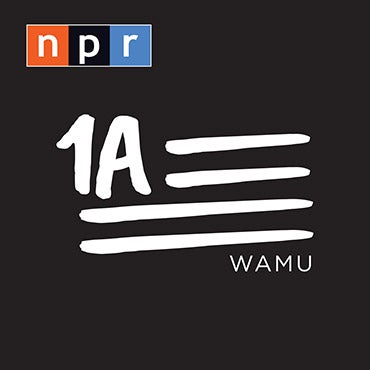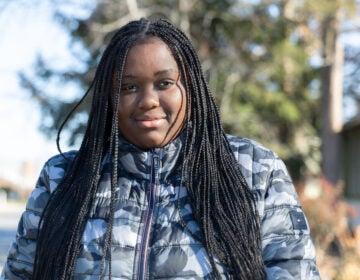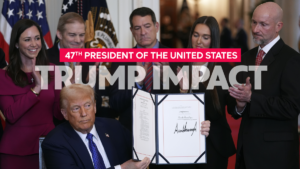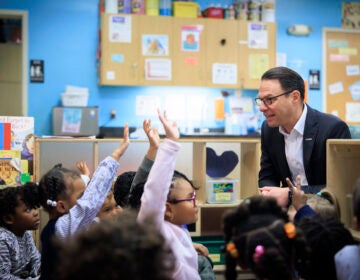White House launches foster care program; Philly child welfare experts hopeful but see gaps in prevention, housing and relationships
The executive order calls for scholarships, especially at faith-based institutions such as Villanova University. But experts say what foster youth need the most is guidance.

President Donald Trump listens as first lady Melania Trump speaks during an event on foster care in the East Room of the at the White House, Thursday, Nov. 13, 2025, in Washington. (AP Photo/Jacquelyn Martin)
From Philly and the Pa. suburbs to South Jersey and Delaware, what would you like WHYY News to cover? Let us know!
The White House is rolling out a new executive order that aims to reshape how young people transition out of foster care, opening the door to new public and private partnerships. The order, titled “Fostering the Future for American Children and Families,” was announced last week by first lady Melania Trump, who framed it as an effort to give young people “the ability to secure an entry-level job position and in turn, financial independence.”
“Too many people from [the] foster care community end up homeless, in danger on American streets,” she said at the signing, calling the new policy “both empathetic and strategic” and predicting that it would spark a “lasting nationwide movement.”
The order calls for a youth-facing online platform, expanded education pathways and stronger ties between federal agencies, businesses and higher education. Universities including Villanova, Vanderbilt, the University of Miami and Oral Roberts were listed as partners.
Child welfare experts in Philadelphia say they are cautiously optimistic, but add what’s missing may be just as important as what’s included.
A pleasant surprise … and what’s missing
There are over 3,000 youth currently in the foster care system in Philadelphia, according to the city. David Fair, executive director of Turning Points for Children, a subsidiary of Public Health Management Corporation, says that’s a significant decrease since a few years ago, when the number hovered around 6,000. A few hundred youths transition out of foster care each year.
Fair said he was surprised to see the Trump administration take on this issue at all.
“The Trump administration both the last time and this time were not very responsive to issues related to child welfare,” Fair said. “So I think it’s a great step.”
He said he hopes it helps motivate a better understanding of the issue and leads to systemic change at the local level, getting more people in education and the private sector involved.
“Philadelphia also has some of the most progressive policies and supports older youth, but it’s just so overwhelming without the support of the business community and the universities and colleges,” he said.
Johanna Greeson, associate professor at the University of Pennsylvania and managing faculty director of the Field Center for Children’s Policy, Practice & Research, agreed, saying that she applauded the effort to modernize child welfare data and build an online platform to help youth access resources.
Greeson, who worked on a similar project called Youth Matters Philly, said the website could be useful “depending on how it’s designed and how it’s rolled out.”
“I hope in their process they turned to the lived experts on design considerations, meaning young people themselves, experts on their experiences and being able to say, ‘This is what we need,’” she said.
However, both Fair and Greeson pointed to the absence of prevention efforts, saying upstream support is rarely funded at the level needed to reduce the number of children entering foster care in the first place.
According to statistics, the most prevalent reasons children are sent into foster care are parents’ substance abuse and abuse and neglect.
“Prevention is never funded the way it should be funded,” Greeson said. “If we could reduce the rate of child maltreatment and the need for foster care in this country and put that set of services out of business, that would be amazing.”
Higher learning
The executive order is promoting a coordinated national push to help young people who have experienced foster care transition more successfully into adulthood and create more capacity in the system. One of the key goals of Fostering the Future is expanding “to develop partnerships with agencies and leading private sector organizations, academic institutions and non-profit entities to create new educational and employment opportunities for individuals who are in or are transitioning out of the foster care system.”
“Fostering the Future sets these individuals on their career paths, but more significantly, it equips each scholarship recipient with a foundation of knowledge that will endure throughout their lifetimes, permanency for those who embody the fleeting,” Melania Trump said at the White House.
However, both Fair and Greeson say that, while the intention behind that may be good, providing more scholarships for these “special needs” students doesn’t address the underlying issues.
For one thing, Greeson explains, such financial aid already exists, but the bigger problem is not money.
“Most of these kids automatically qualify for as much financial aid as anyone would ever get because of their status,” she said. “Who’s responsible for helping these young people navigate the college application process? Nobody is assigned that responsibility, and so it falls on foster parents or caseworkers that are willing to help.”
Foster youth who do manage to complete high school while in foster care and then attend college don’t fare well — among those who enroll, only 5–7% complete a bachelor’s degree and only about 8–12% complete any postsecondary credential by their late 20s.
“They’re not as prepared as the typical high school graduate,” Fair said. “Just like any other sort of special needs student, the universities and colleges need to help prepare these kids to succeed in college — don’t just throw them in there and hope that they succeed.”
In order to better ensure success, Greeson said it would be better to focus on providing housing, which a lot of current financial assistance does not provide, and programs that provide what she calls “relationship permanence,” giving youth associations that are more consistent and that can help guide them through their transition to independence.
The executive order notes that foster youth would be connected to “mentoring services” through the new website, something Greeson said may be a “step” toward building those necessary relationships.
“While mentoring is in scope via this executive order, it needs to be funded and measured in durable ways such that we actually achieve relational permanence for these young people,” she said.
She added that she works with around 20 colleges and universities in Pennsylvania that already have robust programs focused on helping former foster youth, but that Villanova University is not among them.
Fair said Villanova may have been chosen because of its religious orientation, given the executive order’s focus on “faith-based” partners.
“I connected that to the part of the executive order that refers to not penalizing foster parents because of their spiritual beliefs and the anti-trans phrase that was in the executive order,” he said. “I figure Villanova is a safer school for them because of those conditions that are in the executive order as opposed to a more progressive college like Temple or Penn.”
The White House, the Office of the First Lady and Villanova University did not respond to questions relating to the partnership.

Get daily updates from WHYY News!
WHYY is your source for fact-based, in-depth journalism and information. As a nonprofit organization, we rely on financial support from readers like you. Please give today.








